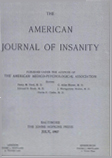NITROUS OXIDE ANOXIA IN THE TREATMENT OF SCHIZOPHRENIA
Abstract
1. Nitrous oxide anoxia has given good results in the treatment of early cases of schizophrenia.
2. Chronic cases, whose illness was over 2 years in duration were unchanged.
3. It is a relatively safe method in the hands of a skilled anæsthetist. The dangers of respiratory failure and irreversible damage to the brain must be remembered.
4. Nitrous oxide anoxia is less time consuming than hypoglycemia, and therefore is available to a larger group of patients.
5. The treatment is less strenuous on the patient and most of them enjoy the daily bout.
6. No accidents or untoward effects have been experienced in our series.
7. Whereas the number of cases treated so far is too small to have much statistical validity, we feel that our results are sufficiently good to warrant treating early cases by this method first. If they fail to improve after a fair trial, they can be transferred to insulin treatment.
8. This technique might be used in general hospitals in treating early cases of schizophrenia.
Access content
To read the fulltext, please use one of the options below to sign in or purchase access.- Personal login
- Institutional Login
- Sign in via OpenAthens
- Register for access
-
Please login/register if you wish to pair your device and check access availability.
Not a subscriber?
PsychiatryOnline subscription options offer access to the DSM-5 library, books, journals, CME, and patient resources. This all-in-one virtual library provides psychiatrists and mental health professionals with key resources for diagnosis, treatment, research, and professional development.
Need more help? PsychiatryOnline Customer Service may be reached by emailing [email protected] or by calling 800-368-5777 (in the U.S.) or 703-907-7322 (outside the U.S.).



